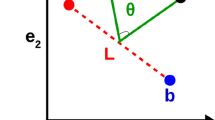Abstract
Various methods of implementing forward and inverse kinematics of six-axes industrial robots are analyzed in this paper from the viewpoint of numerical conditioning and convergence speed both close to a solution and away from it. Computational complexities are derived in terms of the number of arithmetic operations and comparisons are made by observing the actual CPU time consumption. The formulations presented make use of different sets of invariants describing the orientation of the gripper. It is shown that, in inverse kinematics, there is a tradeoff between numerical stability and computational speed.
Similar content being viewed by others
Explore related subjects
Discover the latest articles, news and stories from top researchers in related subjects.References
Tandirci, M., Angeles, J. and Darcovich, J., The role of rotation representations in computational robot kinematics,Proc. 1992 IEEE Int. Conf. Robotics and Automation, Nice, May 12–14, 1992, pp. 344–349.
Pieper, D. L.,The kinematics of Manipulators Under Computer Control, PhD Thesis, Stanford University, 1968.
Takano, M., A new effective solution to inverse kinematics problem of a robot with any type of configuration,J. Faculty of Engineering, The University of Tokyo, Vol.B(2), 107–135 (1985).
Mavroidis, C. and Roth, B., Manipulators with simple inverse kinematics,Proc. Ninth CISMIFToMM Symposium on Theory and Practice of Robots and Manipulators — Romansy 9, Udine, 1–4 September 1992.
Lee, H.-Y. and Liang, C.-G., Displacement analysis of the general spatial 7-link 7R mechanism,Mechanism and Machine Theory 23(3), 219–226 (1988).
Raghavan, M. and Roth, B., Kinematic analysis of the 6R manipulator of general geometry, in H. Miura and S. Arimoto (eds),Proc. 5th Int. Sympos. Rob. Res., MIT Press Cambridge, Mass, 1990, pp. 263–269.
Angeles, J., On the numerical solution of the inverse kinematics problem,Int. J. Robotics Res. 2 21–36 (1985).
Goldenberg, A. A., Benhabib, B. and Fenton, R. G., A complete generalized solutions to the inverse kinematics of robots,IEEE J. Robotics Automat. RA-1 14–20 (1985).
Tsai, L. W. and Morgan, A. P., Solving the kinematics of the most general six and five-degree-of-freedom manipulators by continuation methods',ASME J. Mech. Transmissions Automat. Design 107(2), 189–200 (1985).
Eppinger, M. and Kreuzer, E., Evaluation of methods for solving the inverse kinematics of manipulators, Meerestechnik II — Strukturmechanik Technical report, Technische Universität Hamburg, Hamburg (1990).
Hartenberg, R. S. and Denavit, J.,Kinematic Synthesis of Linkages, McGraw-Hill, New York (1964).
Funda, J. and Paul, R. P., A computational analysis of screw transformations in robotics,IEEE Trans. Robot. Automat. 6(3), 348–356 (1989).
Angeles, J.,Rational Kinematics, Springer-Verlag, New York (1988).
Cheng, H. and Gupta, K. C., An historical note on finite rotations,ASME J. Appl. Mech. 56 139–142 (1989).
Angeles, J., Die theoretischen Grundlagen zur Behandlung algebraischer Singularitäten der kinematischen Koordinatetenumkehr in der Robotertechnik,Mech. Mach. Theory 26(3), 315–322 (1991).
Rodrigues, O., Des lois géométriques qui régissent les déplacements d'un système solide dans l'espace, et la variation des coordonnées provenant de ces déplacements considérés indépendamment des causes qui peuvent les produire.J. Math. Pures Appl. 5 380–440 (1840).
Tandirci, M., Contributions to on-line robot kinematics, MEng Thesis, Dept of Mechanical Engineering, McGill University, Montreal (1991).
Whitney, D. E., The mathematics of coordinated control of prosthetic arms and manipulators,ASME J. Dyn. Sys. Meas. Contr. 94(14), 303–309 (1972).
Press, W. H., Flannery, B. P., Teukolsky, S. A. and Vetterling, W. T.,Numerical Recipes in C, Cambridge University Press, Cambridge (1988).
Author information
Authors and Affiliations
Additional information
An abridged version of this paper was presented in the 1992 IEEE International Conference on Robotics and Automation, 1992 [1].
Rights and permissions
About this article
Cite this article
Tandirci, M., Angeles, J. & Darcovich, J. On rotation representations in computational robot kinematics. J Intell Robot Syst 9, 5–23 (1994). https://doi.org/10.1007/BF01258311
Received:
Issue Date:
DOI: https://doi.org/10.1007/BF01258311




